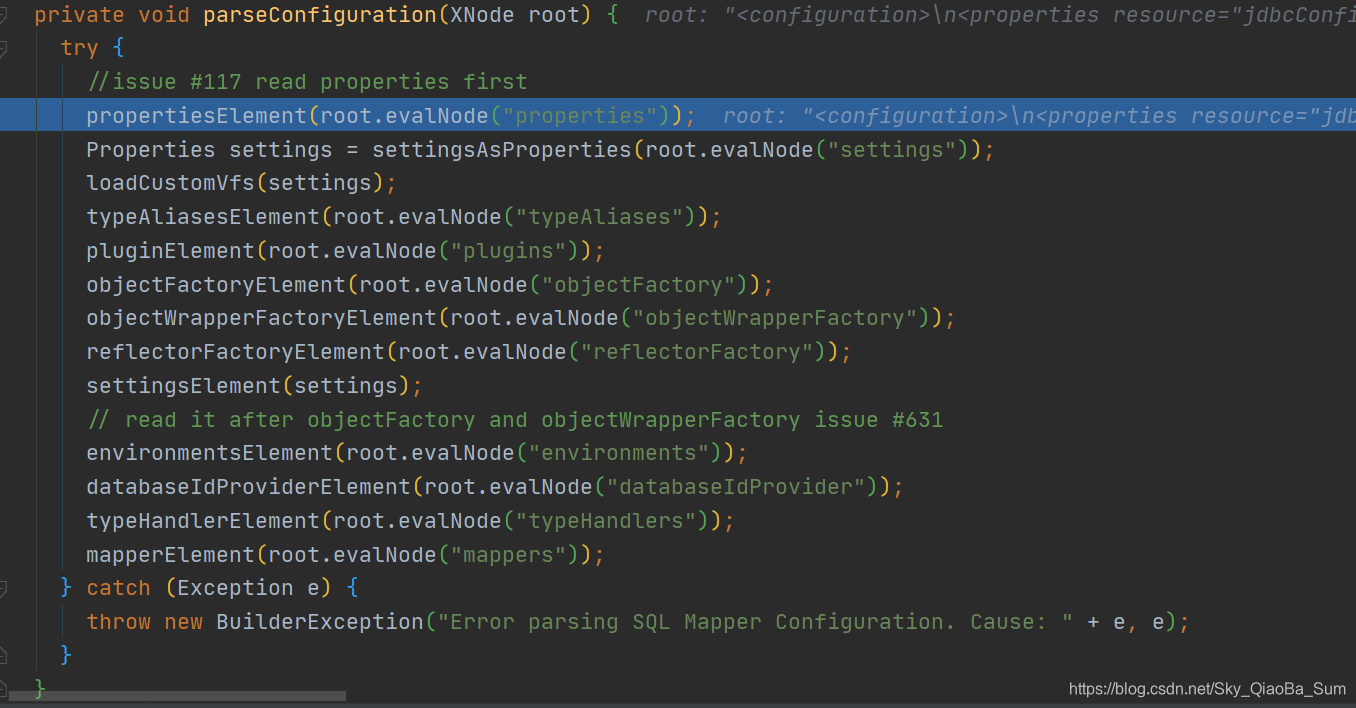mybatis原始碼學習:從SqlSessionFactory到代理物件的生成
阿新 • • 發佈:2020-04-25
[toc]
# 一、根據XML配置檔案構建SqlSessionFactory
一、首先讀取類路徑下的配置檔案,獲取其位元組輸入流。
二、建立SqlSessionFactoryBuilder物件,呼叫內部的build方法。`factory = new SqlSessionFactoryBuilder().build(in);`
三、根據位元組輸入流建立XMLConfigBuilder即解析器物件parser。`XMLConfigBuilder parser = new XMLConfigBuilder(inputStream, environment, properties);`
```java
public SqlSessionFactory build(InputStream inputStream, String environment, Properties properties) {
try {
//根據位元組輸入流建立XMLConfigBuilder即解析器物件parser
XMLConfigBuilder parser = new XMLConfigBuilder(inputStream, environment, properties);
//返回的Configuration配置物件作為build的引數
return build(parser.parse());
} catch (Exception e) {
throw ExceptionFactory.wrapException("Error building SqlSession.", e);
} finally {
ErrorContext.instance().reset();
try {
inputStream.close();
} catch (IOException e) {
// Intentionally ignore. Prefer previous error.
}
}
}
```
四、呼叫parser物件的parse方法,`parser.parse()`,該結果將返回一個Configuration配置物件,作為build方法的引數。
五、parse()方法中,呼叫parseConfiguration方法將Configuration元素下的所有配置資訊封裝進Parser物件的成員Configuration物件之中。
```java
public Configuration parse() {
if (parsed) {
throw new BuilderException("Each XMLConfigBuilder can only be used once.");
}
parsed = true;
//將configuration的配置資訊一一封裝到configuration中
parseConfiguration(parser.evalNode("/configuration"));
return configuration;
}
```
六、其中進行解析xml元素的方式是將通過evalNode方法獲取對應名稱的節點資訊。如:`parseConfiguration(parser.evalNode("/configuration"));`,此時`parser.evalNode("/configuration")`即為Configuration下的所有資訊。
七、parseConfiguration方法相當於將裡面每個元素的資訊都單獨封裝到Configuration中。

值得一提的是,我們之後要分析基於代理模式產生dao的代理物件涉及到mappers的封裝,其實也在配置檔案讀取封裝的時候就已經完成,也就是在parseConfiguration方法之中:`mapperElement(root.evalNode("mappers"));`。他的作用就是,讀取我們主配置檔案中``的元素內容,也就是我們配置的對映配置檔案。
```xml
```
`private void mapperElement(XNode parent)`方法將mappers配置下的資訊獲取,此處獲取我們resources包下的com.smday.dao包名。

接著就呼叫了configuration的addMappers方法,其實還是呼叫的是mapperRegistry。
```java
public void addMappers(String packageName) {
mapperRegistry.addMappers(packageName);
}
```
讀到這裡,我們就會漸漸瞭解MapperRegistry這個類的職責所在,接著來看,這個類中進行的一些工作,在每次新增mappers的時候,會利用ResolverUtil類查詢類路徑下的該包名路徑下,是否有滿足條件的類,如果有的話,就將Class物件新增進去,否則報錯。


緊接著,就到了一步比較重要的部分,當然只是我個人覺得,因為第一遍看的時候,我沒有想到,這步居然可以封裝許許多多的重要資訊,我們來看一看:
```java
public void addMapper(Class type) {
if (type.isInterface()) {
//如果已經繫結,則丟擲異常
if (hasMapper(type)) {
throw new BindingException("Type " + type + " is already known to the MapperRegistry.");
}
boolean loadCompleted = false;
try {
//將介面類作為鍵,將MapperProxyFactory作為值存入
knownMappers.put(type, new MapperProxyFactory(type));
// 在執行解析器之前新增型別十分重要,否則可能會自動嘗試繫結對映器解析器
// 如果型別已知,則不會嘗試
MapperAnnotationBuilder parser = new MapperAnnotationBuilder(config, type);
//解析mapper對映檔案,封裝資訊
parser.parse();
loadCompleted = true;
} finally {
if (!loadCompleted) {
knownMappers.remove(type);
}
}
}
}
```
對映配置檔案的讀取依靠namespace,我們可以通過檢視原始碼發現讀取對映配置檔案的方法是loadXmlResouce(),所以namespace名稱空間至關重要:
```java
private void loadXmlResource() {
// Spring may not know the real resource name so we check a flag
// to prevent loading again a resource twice
// this flag is set at XMLMapperBuilder#bindMapperForNamespace
// 防止載入兩次,可以發現這句 判斷在許多載入資原始檔的時候出現
if (!configuration.isResourceLoaded("namespace:" + type.getName())) {
String xmlResource = type.getName().replace('.', '/') + ".xml";
InputStream inputStream = null;
try {
inputStream = Resources.getResourceAsStream(type.getClassLoader(), xmlResource);
} catch (IOException e) {
// ignore, resource is not required
}
if (inputStream != null) {
XMLMapperBuilder xmlParser = new XMLMapperBuilder(inputStream, assistant.getConfiguration(), xmlResource, configuration.getSqlFragments(), type.getName());
//最終解析
xmlParser.parse();
}
}
}
```
```java
//xmlPaser.parse()
public void parse() {
if (!configuration.isResourceLoaded(resource)) {
//讀取對映配置檔案資訊的主要程式碼
configurationElement(parser.evalNode("/mapper"));
//載入完成將該路徑設定進去,防止再次載入
configuration.addLoadedResource(resource);
bindMapperForNamespace();
}
parsePendingResultMaps();
parsePendingCacheRefs();
parsePendingStatements();
}
```

可以看到,對對映檔案解析之後,mappedStatements物件中出現了以下內容:

至此,主配置檔案和對映配置檔案的配置資訊就已經讀取完畢。
八、最後依據獲得的Configuration物件,建立一個`new DefaultSqlSessionFactory(config)`。
```java
public SqlSessionFactory build(Configuration config) {
return new DefaultSqlSessionFactory(config);
}
```
總結:
- 解析配置檔案的資訊,並儲存在Configuration物件中。
- 返回包含Configuration的DefaultSqlSession物件。
# 二、通過SqlSessionFactory建立SqlSession
一、呼叫SqlSessionFactory物件的openSession方法,其實是呼叫`private SqlSession openSessionFromDataSource(ExecutorType execType, TransactionIsolationLevel level, boolean autoCommit)`方法,通過引數就可以知道,分別是執行器的型別,事務隔離級別和設定是否自動提交,因此,我們就可以得知,我們在建立SqlSession的時候可以指定這些屬性。
```java
private SqlSession openSessionFromDataSource(ExecutorType execType, TransactionIsolationLevel level, boolean autoCommit) {
Transaction tx = null;
try {
//獲取Environment資訊
final Environment environment = configuration.getEnvironment();
//獲取TransactionFactory資訊
final TransactionFactory transactionFactory = getTransactionFactoryFromEnvironment(environment);
//建立Transaction物件
tx = transactionFactory.newTransaction(environment.getDataSource(), level, autoCommit);
//建立執行器物件Executor
final Executor executor = configuration.newExecutor(tx, execType);
//建立DefaultSqlSession物件並返回
return new DefaultSqlSession(configuration, executor, autoCommit);
} catch (Exception e) {
closeTransaction(tx); // may have fetched a connection so lets call close()
throw ExceptionFactory.wrapException("Error opening session. Cause: " + e, e);
} finally {
ErrorContext.instance().reset();
}
}
```
二、從configuration中獲取environment、dataSource和transactionFactory資訊,建立事務物件Transaction。

補充:後續看了一些部落格,說是保證executor不為空,因為defaultExecutorType有可能為空。
三、根據配置資訊,執行器資訊和自動提交資訊建立DefaultSqlSession。
# 三、getMapper獲取動態代理物件
下面這句話意思非常明瞭,就是通過傳入介面型別物件,獲取介面代理物件。
`IUserDao userDao1 = sqlSession1.getMapper(IUserDao.class);`
具體的過程如下:
一、首先,呼叫SqlSession的實現類DefaultSqlSession的getMapper方法,其實是在該方法內呼叫configuration的getMapper方法,將介面類物件以及當前sqlsession物件傳入。
```java
//DefaultSqlSession.java
@Override
public T getMapper(Class type) {
//呼叫configuration的getMapper
return configuration.getMapper(type, this);
}
```
二、接著呼叫我們熟悉的mapperRegistry,因為我們知道,在讀取配置檔案,建立sqlSession的時候,介面型別資訊就已經被存入到其內部維護的Map之中。
```java
//Configuration.java
public T getMapper(Class type, SqlSession sqlSession) {
return mapperRegistry.getMapper(type, sqlSession);
}
```

三、我們來看看getMapper方法具體的實現如何:
```java
public T getMapper(Class type, SqlSession sqlSession) {
//根據傳入的型別獲取對應的鍵,也就是這個代理工廠
final MapperProxyFactory mapperProxyFactory = (MapperProxyFactory) knownMappers.get(type);
if (mapperProxyFactory == null) {
throw new BindingException("Type " + type + " is not known to the MapperRegistry.");
}
try {
//最終返回的是代理工廠產生的一個例項物件
return mapperProxyFactory.newInstance(sqlSession);
} catch (Exception e) {
throw new BindingException("Error getting mapper instance. Cause: " + e, e);
}
}
```
四、緊接著,我們進入MapperProxyFactory,真真實實地發現了建立代理物件的過程。
```java
protected T newInstance(MapperProxy mapperProxy) {
//建立MapperProxy代理物件
return (T) Proxy.newProxyInstance(mapperInterface.getClassLoader(), new Class[] { mapperInterface }, mapperProxy);
}
public T newInstance(SqlSession sqlSession) {
//MapperProxy是代理類,
final MapperProxy mapperProxy = new MapperProxy(sqlSession, mapperInterface, methodCache);
return newInstance(mapperProxy);
}
```
